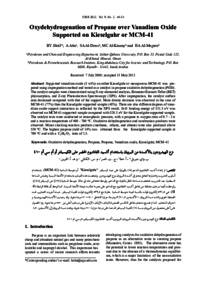Document
Oxydehydrogenation of propane over vanadium oxide supported on kieselguhr or MCM-41.
Contributors
Publisher
Sultan Qaboos University
Gregorian
2012
Language
English
English abstract
Supported vanadium oxide (5 wt%) on either Kieselguhr or mesoporous MCM-41 was prepared using impregnation method and tested as a catalyst in propane oxidative dehydrogenation (POD). The catalyst samples were characterized using X-ray elemental analysis, Brunauer-Emmett-Teller (BET) physisorption, and Z-ray Photoelectron Spectroscopy (XPS). After impregnation, the catalyst surface area decreased compared with that of the support. More drastic decrease was observed in the case of MCM-41 (77%) than the Kieselguhr supported sample (48%). There are also different degrees of vanadium oxide-support interaction as reflected by the XPS result. Si-O binding energy of 531.5 eV was observed on MCM-41-supported sample compared with 529.5 eV for the Kieselguhr-supported sample. The catalyst tests were conducted at atmospheric pressure, with a propane to oxygen ratio of 0.7 - 3.6 and a reaction temperature of 400 - 700 °C. Oxidative dehydrogenation and combustion products were observed. Minor cracking reaction products (methane, ethane, and ethene) were also produced above 550 °C. The highest propene yield of 14% was obtained from the Kieselguhr-supported sample at 700 °C and with a C3H8/O2 ratio of 1.5.
Member of
ISSN
1726-6742
Resource URL
Citation
Jibril, B. Y., Atta, A., AlDress, S. A., AlKinany, M. C., & AlMegren, H. A. (2012). Oxydehydrogenation of propane over vanadium oxide supported on kieselguhr or MCM-41. The Journal of Engineering Research, 9 (1), 46-54.
Arabic abstract
تم إعداد أكسيد الفاناديوم المدعم (5% بالوزن) على عينه كيسيلغر "Kieselguhr" أو متوسط المسامية (41 - MCM) باستخدام أسلوب التشريب واختبارها كعامل محفز في أكسدة البروبان بنزع الهيدروجين. وشخصت هذه العينات باستخدام الأشعة السينية ومقياس المساحة السطحية. بعد التشريب، انخفضت مساحة الحافز بالمقارنة مع الداعم. ولوحظ انخفاض حاد في حالة متوسط المسامية (77%) عن كيسيلغر (48%). ولوحظت أيضا درجات مختلفة من تفاعل أكسيد الفاناديوم مع الداعم على نحو ما تعكسه نتيجة الأشعة السينية. كما لوحظ أن طاقة الرابطة (0-SI) هي 531.5 إلكترون فولت بالنسبة لعينة متوسط المسامية مقارنة مع 529.5 إلكترون فولت للعينة كيسيلغر. حيث أجريت التجارب تحت الضغط الجوي وكانت نسبة البروبان – الأكسجين 0.7-3.6، ودرجة حرارة التفاعل 400-700 درجة مئوية. وقد رصدت الأكسدة الهيدروجينية واحتراق المنتجات. كما تم تصنيع منتجات تفاعل التكسير الصغيرة (الميثان، الإيثان، الإيثين) على درجات أعلى من 500 درجة مئوية. وتم الحصول على أعلى محصول من البروبان بنسبة 14% للعينة كيسيلغر المدعمة على درجة حرارة 700 درجة مئوية، وبلغت نسبة البروبان إلى الأكسجين 1.5.
Category
Journal articles

